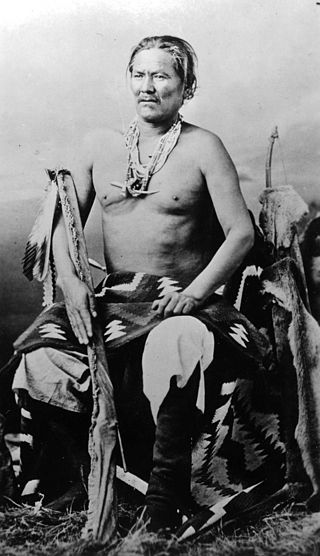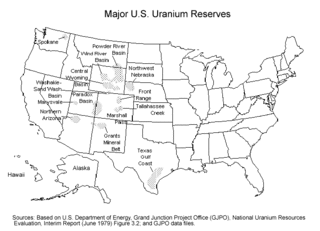
Church Rock is a census-designated place (CDP) in McKinley County, New Mexico, United States. The population was 1,128 at the 2010 census. Church Rock is named for Church Rock, a prominent natural landmark with the same name.


An Indian reservation is an area of land held and governed by a U.S. federal government-recognized Native American tribal nation, whose government is semi-sovereign, subject to regulations passed by the United States Congress and administered by the United States Bureau of Indian Affairs, and not to the U.S. state government in which it is located. Some of the country's 574 federally recognized tribes govern more than one of the 326 Indian reservations in the United States, while some share reservations, and others have no reservation at all. Historical piecemeal land allocations under the Dawes Act facilitated sales to non–Native Americans, resulting in some reservations becoming severely fragmented, with pieces of tribal and privately held land being treated as separate enclaves. This jumble of private and public real estate creates significant administrative, political, and legal difficulties.

The Navajo are a Native American people of the Southwestern United States.

The United States Radiation Exposure Compensation Act (RECA) is a federal statute implemented in 1990, set to expire in July 2024, providing for the monetary compensation of people, including atomic veterans, who contracted cancer and a number of other specified diseases as a direct result of their exposure to atmospheric nuclear testing undertaken by the United States during the Cold War as residents, or their exposure to radon gas and other radioactive isotopes while undertaking uranium mining, milling or the transportation of ore.

Radium and radon are important contributors to environmental radioactivity. Radon occurs naturally as a result of decay of radioactive elements in soil and it can accumulate in houses built on areas where such decay occurs. Radon is a major cause of cancer; it is estimated to contribute to ~2% of all cancer related deaths in Europe.
Uranium in the environment is a global health concern, and comes from both natural and man-made sources. Mining, phosphates in agriculture, weapons manufacturing, and nuclear power are sources of uranium in the environment.

Uranium mining in the United States produced 173,875 pounds (78.9 tonnes) of U3O8 in 2019, 88% lower than the 2018 production of 1,447,945 pounds (656.8 tonnes) of U3O8 and the lowest US annual production since 1948. The 2019 production represents 0.3% of the anticipated uranium fuel requirements of the US's nuclear power reactors for the year.

Uranium mining in Arizona has taken place since 1918. Prior to the uranium boom of the late 1940s, uranium in Arizona was a byproduct of vanadium mining of the mineral carnotite.
Uranium mining in New Mexico was a significant industry from the early 1950s until the early 1980s. Although New Mexico has the second largest identified uranium ore reserves of any state in the United States, no uranium ore has been mined in New Mexico since 1998.

The Return of Navajo Boy is a documentary film produced by Jeff Spitz and Bennie Klain about the Cly family, Navajo who live on their reservation. Through them, the film explores several longstanding issues among the Navajo and their relations with the United States government and corporations: environmental racism, media and political representation, off-reservation adoption, and denial of reparations for environmental illnesses due to uranium mining in Monument Valley, Utah, which was unregulated for decades. Bill Kennedy served as the film's executive producer; his late father had produced and directed the earlier silent film The Navajo Boy (1950s), which featured the Cly family.
The Navajo Boy (1950s) was a silent film that portrayed the Cly family on the Navajo Nation in Monument Valley, Utah. The director, Robert J. Kennedy, narrated the film live at each showing. In addition, he provided little written information about the context or the identities of the Navajo people featured in the film.

The Church Rock uranium mill spill occurred in the U.S. state of New Mexico on July 16, 1979, when United Nuclear Corporation's tailings disposal pond at its uranium mill in Church Rock breached its dam. The accident remains the largest release of radioactive material in U.S. history, having released more radioactivity than the Three Mile Island accident four months earlier.

In the 1950s, the Navajo Nation was situated directly in the uranium mining belt that experienced a boom in production, and many residents found work in the mines. Prior to 1962, the risks of lung cancer due to uranium mining were unknown to the workers, and the lack of a word for radiation in the Navajo language left the miners unaware of the associated health hazards. The cultural significance of water for the Navajo people and the environmental damage to both the land and livestock inhibits the ability of the Navajo people to practice their culture.

The uranium mining debate covers the political and environmental controversies of uranium mining for use in either nuclear power or nuclear weapons.

Nuclear ethics is a cross-disciplinary field of academic and policy-relevant study in which the problems associated with nuclear warfare, nuclear deterrence, nuclear arms control, nuclear disarmament, or nuclear energy are examined through one or more ethical or moral theories or frameworks. In contemporary security studies, the problems of nuclear warfare, deterrence, proliferation, and so forth are often understood strictly in political, strategic, or military terms. In the study of international organizations and law, however, these problems are also understood in legal terms. Nuclear ethics assumes that the very real possibilities of human extinction, mass human destruction, or mass environmental damage which could result from nuclear warfare are deep ethical or moral problems. Specifically, it assumes that the outcomes of human extinction, mass human destruction, or environmental damage count as moral evils. Another area of inquiry concerns future generations and the burden that nuclear waste and pollution imposes on them. Some scholars have concluded that it is therefore morally wrong to act in ways that produce these outcomes, which means it is morally wrong to engage in nuclear warfare.
The World Uranium Hearing was held in Salzburg, Austria in September 1992.Anti-nuclear speakers from all continents, including indigenous speakers and scientists, testified to the health and environmental problems of uranium mining and processing, nuclear power, nuclear weapons, nuclear tests, and radioactive waste disposal.

The International Uranium Film Festival was founded in 2010 in Rio de Janeiro, and has traveled to Germany, Portugal, India and the United States. This educational event merges art, ecology, environmentalism and environmental justice, to inform the public about uranium mining and milling, nuclear power issues, nuclear weapons and the nuclear fuel cycle from "cradle to grave" life-cycle assessment - and the effects of radioactivity on humans and other species. The festival founders and principal organizers are Norbert Suchanek and Marcia Gomes de Oliveira. The legal organizer of the International Uranium Film Festival is the arts and education non-profit "Yellow Archives". The organizers and the festival participants seek to educate and activate the international public on these issues through the dynamic media of film and video.
The Navajo Uranium Assessment and Kidney Health Project (NUAKHP) was a congressionally mandated study conducted by researchers from the University of New Mexico and Crownpoint IHS Hospital on kidney functions of Navajo Native Americans who lived and worked near decommissioned uranium mines. The long-term goal of the five-year project beginning in 2006, was to use the studies results to develop a kidney health registry to inform concerned people about possible risks of local drinking water.

Wastelanding: Legacies of Uranium Mining in Navajo Country is a 2015 non-fiction book by Traci Brynne Voyles.















